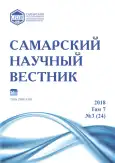Видовое разнообразие и особенности локализации фотобионта в эпигейных лишайниках рода Cladonia
- Авторы: Корчиков Е.С.1, Болгов Е.В.1, Ильина Е.С.1, Панкратов Т.А.2
-
Учреждения:
- Самарский национальный исследовательский университет имени академика С.П. Королёва
- Московский государственный университет имени М.В. Ломоносова
- Выпуск: Том 7, № 3 (2018)
- Страницы: 59-64
- Раздел: 03.02.00 – общая биология
- URL: https://journals.rcsi.science/2309-4370/article/view/21688
- DOI: https://doi.org/10.17816/snv201873111
- ID: 21688
Цитировать
Полный текст
Аннотация
В данной статье рассматривается таксономический состав и особенности локализации фотобионтов в кустистых эпигейных лишайниках рода Cladonia. Описываются количество и видовая принадлежность клеток водорослей в гомогенатах талломов в зависимости от их возраста: в зонах активного роста, старения и разложения, а также в смывах с талломов. Рассматривается влияние микобионта на видовой состав и численность фотобионта. Приводится сравнение этих данных в лишайниках северотаёжной зоны (Мурманская область) и степной зоны (Оренбургская область). Определение таксономической принадлежности фотобионтов к роду определяли методом прямой микроскопии с использованием морфологических критериев: размер, форма клеток, характер хроматофора и т.п. Численность фотобионта в образцах исследовали как методом световой микроскопии, так и с помощью флуоресцентной микроскопии. В работе представлены результаты сравнения численности и разнообразия водорослей в талломах эпигейных лишайников рода Cladonia в зависимости от их географической локализации и характера возрастной динамики подециев. Проведённые исследования показали, что доминирующими группами в активно растущих подециях лишайников были представители рода Asterochloris вне зависимости от их географической локализации. В лишайниках обнаружены представители родов Chlorella, Stichococcus, Pseudococcomyxa. Новыми для науки оказались сведения об изменении таксономического состава водорослей в зависимости от возраста таллома: в старых частях северотаёжных лишайников доминировали водоросли Pseudococcomyxa, а в степных – Stichococcus. Сделана попытка ресинтеза лишайникового таллома из ранее изолированных культур микобионта и фотобионта. На данном этапе исследований она оказалась неудачной.
Полный текст
Открыть статью на сайте журналаОб авторах
Евгений Сергеевич Корчиков
Самарский национальный исследовательский университет имени академика С.П. Королёва
Email: evkor@inbox.ru
кандидат биологических наук, доцент кафедры экологии, ботаники и охраны природы
Россия, СамараЕгор Владимирович Болгов
Самарский национальный исследовательский университет имени академика С.П. Королёва
Email: egrk.krge@gmail.com
студент биологического факультета
Россия, СамараЕлена Сергеевна Ильина
Самарский национальный исследовательский университет имени академика С.П. Королёва
Email: ilinahelen@mail.ru
студент биологического факультета
Россия, СамараТимофей Анатольевич Панкратов
Московский государственный университет имени М.В. Ломоносова
Автор, ответственный за переписку.
Email: tpankratov@mail.ru
кандидат биологических наук, руководитель проекта, кафедра биологии почв
Россия, МоскваСписок литературы
- Панкратов Т.А., Качалкин А.В., Корчиков Е.С., Добровольская Т.Г. Микробные сообщества лишайников // Микробиология. 2017. Т. 86, № 3. С. 1-19.
- Grube M., Berg G. Microbial consortia of bacteria and fungi with focus on the lichen symbiosis // Fungal Biology Reviews. 2009. Vol. 23. P. 72-85.
- Bates S.T., Cropsey G.W.G., Caporaso J.G., Knight R., Fierer N. Bacterial communities associated with the lichen symbiosis // Appl. and Environ. Microbiol. 2011. Vol. 77 (4). P. 1309-1314.
- Паносян А.К., Никогосян В.Г. Очерк микрофлоры лишайников Армении // Биологический журнал Армении. 1969. Т. 22, № 1. С. 3-10.
- Качалкин А.В., Глушакова А.М., Панкратов Т.А. Дрожжевое население лишайников полуострова Киндо // Микробиология. 2017. Т. 86, № 6. С. 762-769.
- Панкратов Т.А. Бактериальные комплексы лишайников Хибин на примере Cladonia uncialis, C. portentosa, Alectoria ochroleuca, и Nephroma arcticum // Микробиология. 2018. Т. 87, № 1. С. 70-78.
- Ruprecht U., Brunauer G., Türk R. High photobiont diversity in the common European soil crust lichen Psora decipiens // Biodiversity and Conservation. 2014. Vol. 23. P. 1771-1785.
- Определитель лишайников СССР. Кладониевые и акароспоровые / под ред. И.И. Абрамова. Л.: Наука, 1978. Вып. 5. 304 с.
- Сонина А.В., Степанова В.И., Тарасова В.Н. Лишайники. Морфология, анатомия, систематика. Петрозаводск: ПетрГУ, 2006. Ч. 1. 216 с.
- Голубкова Н.С. Анализ флоры лишайников Монголии. Л.: Наука, 1983. 248 с.
- Голубкова Н.С., Бязров Л.Г. Жизненные формы лишайников и лихеносинузий // Бот. журн. 1989. Т. 74, № 6. С. 794-804.
- Protocols in lichenology culturing, biochemistry, ecophysiology and use in biomonitoring / ed. by I. Kranner, R. Beckett, A. Varma. Heidelberg: Springer, 2002. 46 p.
- Мошкова Н.А., Голлербах М.М. Определитель пресноводных водорослей СССР. Зелёные водоросли. Класс улотриксовые. Л.: Наука, 1986. Вып. 10 (1). 360 с.
- Андреева В.М. Почвенные и аэрофильные зеленые водоросли (Сhlophyta: Tetrasporales, Chlorococcales, Chlorosarcinales). СПб.: Наука, 1998. 349 с.
- Корнейкова М.В., Редькина В.В., Шалыгина Р.Р. Альго-микологическая характеристика почв в сосновом и березовом лесах на территории заповедника «Пасвик» // Почвоведение. 2018. № 2. С. 211-220.
- Moya P., Molins A., Martínez-Alberola F., Muggia L., Barreno E. Unexpected associated microalgal diversity in the lichen Ramalina farinacea is uncovered by pyrosequencing analyses // PLoS ONE, 2017. Vol. 12, № 4. P. 1-21.
- Řídká T., Peksa O., Rai H., Upreti D.K., Škaloud P. Photobiont diversity in Indian Cladonia lichens, with special emphasis on the geographical patterns // Terricolous lichens in India. New York: Springer, 2014. P. 53-71.
- Жизнь растений. Водоросли и лишайники / под ред. М.М. Голлербаха. М.: Просвещение, 1977. Т. 3. С. 378-487.
- Шапиро И.А. Загадки растения-сфинкса. Лишайники и экологический мониторинг. Л.: Гидрометеоиздат, 1991. 96 с.
- Assembling the challenging puzzle of algal biodiversity: species delimitation within the genus Asterochloris (Trebouxiophyceae, Chlorophyta) / P. Skaloud, J. Steinova, T. Rıdka [et al.] // J. Phycol. 2015. Vol. 51. P. 507-527.
- Moya P., Škaloud P., Chiva S., Francisco J. García-Breijo F.J., Reig-Arminnana J., Vančurová L., Barreno E. Molecular phylogeny and ultrastructure of the lichen microalga Asterochloris mediterranea sp. nov. from Mediterranean and Canary islands ecosystems // International Journal of Systematic and Evolutionary Microbiology. 2015. Vol. 65. P. 1838-1854.
Дополнительные файлы










